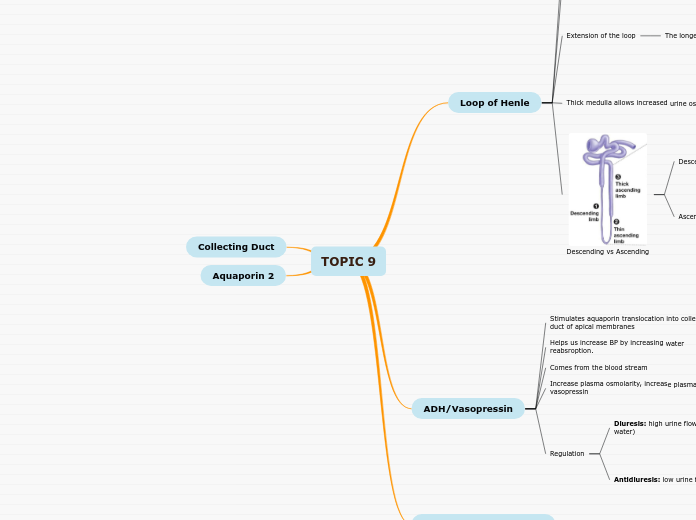TOPIC 9
Loop of Henle
Loops allow fluid to be edited by environment of kidney
Dips down into medulla (where peritubular capillaries/vasa recta are located)
Extension of the loop
The longer the papilla, the longer the loop
Arid species have the longest papilla (need to conserve as much as possible because little access to water)
Mesic species (land/terrestrial) have an "average" papilla (have regular access to water)
Aquatic species have the shortest papilla (don't need to conserve as much water because live in water)
Thick medulla allows increased urine osmolarity
Medulla osmotic gradient determines max urine osmolarity
Thicker medulla --> longer loops --> more concentrated urine --> more reabsorption of water
Descending vs Ascending
Descending
Water permeable (moves out of tubules because of hyperosmotic medulla)
Water moves out to concentrate fluid
Ascending
Thin: Na and Cl are transported actively out of tubule (movement of solutes out = lower osmolarity = hypoosmotic fluid)
Thick: NaKCl cotransporter 2 (NKCC2) absorbs NaCl. Gap junctions are leaky and allow Na+ to slip through
ADH/Vasopressin
Stimulates aquaporin translocation into collecting duct of apical membranes
Helps us increase BP by increasing water reabsroption.
Comes from the blood stream
Increase plasma osmolarity, increase plasma vasopressin
Regulation
Diuresis: high urine flow rate (unable to retain water)
low urine osmolarity
stimulated by low plasma osmolarity
U/P < 1
Antidiuresis: low urine flow rate
high urine osmolarity
stimulated by high plasma osmolarity
U/P > 1
